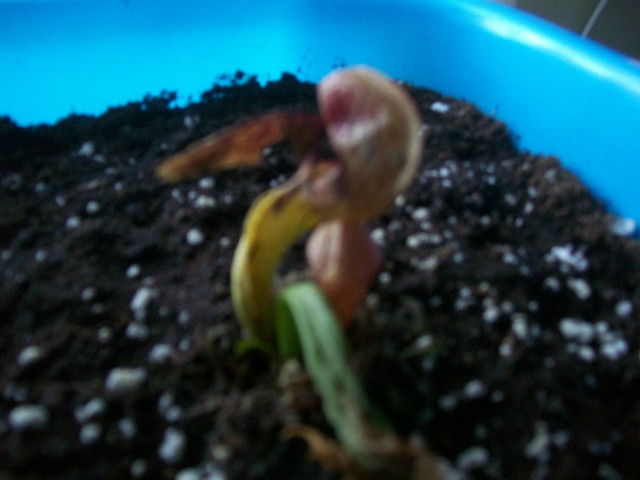Question
 Yellowing cobra lily
Yellowing cobra lily
Hello, I currently got a Darlingtonia from a Lowes two or so weeks ago. I got it adjusted to my house's humidity gradually over a week by opening the container it was in a little bit each day. One the of the heads had grown up in the container in the store, and had collided with the container's roof. The top of it looked smushed, and by the time I started opening the container the second day, it had already started to brown. After that, the other two heads and a new growth looked fine, so I planted that in a mixture of one part peat moss to two parts perlite. I put the container outside where it got dappled sun, but I knew during the day, it was sometimes exposed to full sun. A few days later, I saw that the head most facing the sun had started to brown. The one with the crushed head had already browned some more on downwards. I brought it inside and put it by my bedroom window for the rest of the time till now. My flytrap does well there where they get lots of morning sun, and since the first did fine with my tap water I watered my darlingtonia with it as well, and more recently both with rain water that I've collected. I've tried watering the roots of my cobra lily each day with some cool water. However, now, both of the two good heads left on the cobra lily have the green on their heads browning and the green on their stems turning yellow. The single, small new growth seems to have withered a bit and fallen over, but I cannot be sure. Is the yellowing because the plant is out of sync with its schedule? Or is it because it is dying of some other cause? I live in Brunswick, Georgia.
AnswerHi J,
I'm afraid all you can do at this point is say some final words. Once you see new growth wilting, it's too late. The plants roots are already dead.
Darlingtonia is a fussy customer no matter what you do, plus it has some annoying habits that make the situation worse. One of those is that the leaves can look perfectly normal all the while the roots are dying. By the time the leaves begin wilting the roots are usually gone. I've never been able to bring one back at this point. To make matters worse, these little cubes are the ultimate in bad plant marketing, since they are not established plants, but simple offshoots that look cool, but are not growing, rooted plants. Georgia is also a very difficult place to grow these since you have everything the plant doesn't like. Hot humid summers with warm nights and warm soil temperatures.
If you try another Darlingtonia, my best recommendation is to see if you can obtain some live sphagnum moss to plant it in. They seem to do very well in live sphagnum since it moderates their root temperatures and creates a hospitable environment around their roots. You may actually do better with it indoors in a sunny window during the summer (I'm assuming in Georgia you have AC in your house). That would keep it cooler at night. Be sure to use only rainwater or distilled water on it unless you've actually tested your tapwater to know it has a low mineral content. Late fall and winter the plant would be fine outside. It's native habitat is way colder in the winter than your area. Visit the Darlingtonia link on our website on the caresheet pages for more detailed information. Our DVD, Grow Carnivorous Plants volume #1 also has an entire chapter devoted just to this plant.
One more note has to do with your general experience growing carnivorous plants. If you are fairly new to growing carnivorous plants, wait until you have some successes with Sarracenia, flytraps and some other southern U.S. varieties. These are way easier to grow in your area. We often will not sell a Darlingtonia to a first time grower. We've been growing these for around 25 years, and we still have losses despite providing near identical conditions to their native habitats.
Good Growing!
Jeff Dallas
Sarracenia Northwest
http://www.cobraplant.com






